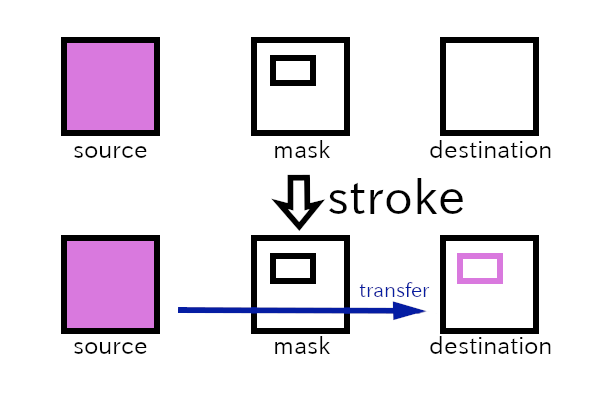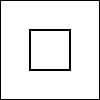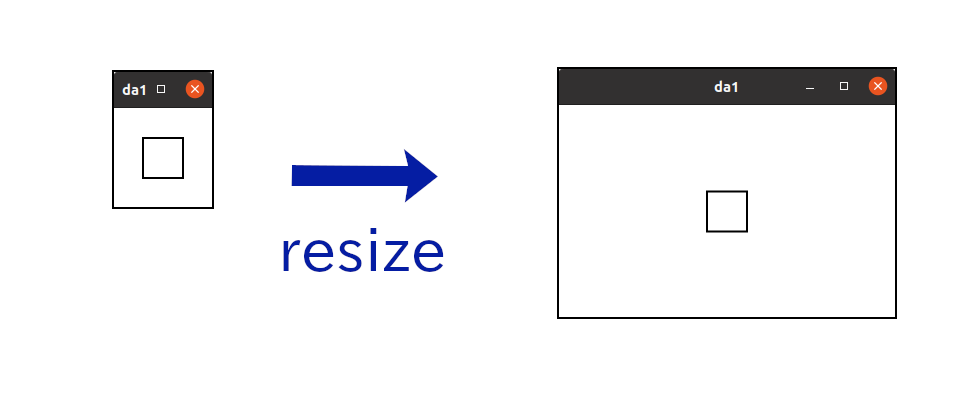
Up: index.html, Prev: Section 21, Next: Section 23
If you want to draw dynamically on the screen, like an image window of gimp graphics editor, the GtkDrawingArea widget is the most suitable widget. You can freely draw or redraw an image in this widget. This is called custom drawing.
GtkDrawingArea provides a cairo drawing context so users can draw images by using cairo functions. In this section, I will explain:
Cairo is a set of two dimensional graphical drawing functions (or graphics library). There is a lot of documentation on Cairo’s website. If you aren’t familiar with Cairo, it is worth reading their tutorial.
The following is a gentle introduction to the Cairo library and how to use it. Firstly, in order to use Cairo you need to know about surfaces, sources, masks, destinations, cairo context and transformations.
cairo_stroke is a function to draw a path to the destination by the transfer.
The instruction is as follows:
cairo_stroke to transfer the paint in the source to the destination.Here’s a simple example program that draws a small square and saves it as a png file.
#include <cairo.h>
int
main (int argc, char **argv)
{
cairo_surface_t *surface;
cairo_t *cr;
int width = 100;
int height = 100;
int square_size = 40.0;
/* Create surface and cairo */
surface = cairo_image_surface_create (CAIRO_FORMAT_RGB24, width, height);
cr = cairo_create (surface);
/* Drawing starts here. */
/* Paint the background white */
cairo_set_source_rgb (cr, 1.0, 1.0, 1.0);
cairo_paint (cr);
/* Draw a black rectangle */
cairo_set_source_rgb (cr, 0.0, 0.0, 0.0);
cairo_set_line_width (cr, 2.0);
cairo_rectangle (cr,
width/2.0 - square_size/2,
height/2.0 - square_size/2,
square_size,
square_size);
cairo_stroke (cr);
/* Write the surface to a png file and clean up cairo and surface. */
cairo_surface_write_to_png (surface, "rectangle.png");
cairo_destroy (cr);
cairo_surface_destroy (surface);
return 0;
}cairo_surface_t is the type of a surface.cairo_t is the type of a cairo context.width and height are the size of surface. square_size is the size of a square to be drawn on the surface.cairo_image_surface_create creates an image surface. CAIRO_FORMAT_RGB24 is a constant which means that each pixel has red, green and blue data, and each data point is an 8 bits number (for 24 bits in total). Modern displays have this type of color depth. Width and height are in pixels and given as integers.cairo_set_source_rgb creates a source pattern, which in this case is a solid white paint. The second to fourth argument are red, green and blue color values respectively, and they are of type float. The values are between zero (0.0) and one (1.0), with black being given by (0.0,0.0,0.0) and white by (1.0,1.0,1.0).cairo_paint copies everywhere in the source to destination. The destination is filled with white pixels with this command.cairo_set_line_width set the width of lines. In this case, the line width is set to be two pixels and will end up that same size. (It is because the transformation is identity. If the transformation isn’t identity, for example scaling with the factor three, the actual width in destination will be six (2x3=6) pixels.)cairo_stroke transfer the source to destination through the rectangle in the mask.rectangle.png.To compile this, type the following.
$ gcc `pkg-config --cflags cairo` cairo.c `pkg-config --libs cairo`
See the Cairo’s website for more details.
The following is a very simple example.
#include <gtk/gtk.h>
static void
draw_function (GtkDrawingArea *area, cairo_t *cr, int width, int height, gpointer user_data) {
int square_size = 40.0;
cairo_set_source_rgb (cr, 1.0, 1.0, 1.0); /* white */
cairo_paint (cr);
cairo_set_line_width (cr, 2.0);
cairo_set_source_rgb (cr, 0.0, 0.0, 0.0); /* black */
cairo_rectangle (cr,
width/2.0 - square_size/2,
height/2.0 - square_size/2,
square_size,
square_size);
cairo_stroke (cr);
}
static void
app_activate (GApplication *app, gpointer user_data) {
GtkWidget *win = gtk_application_window_new (GTK_APPLICATION (app));
GtkWidget *area = gtk_drawing_area_new ();
gtk_window_set_title (GTK_WINDOW (win), "da1");
gtk_drawing_area_set_draw_func (GTK_DRAWING_AREA (area), draw_function, NULL, NULL);
gtk_window_set_child (GTK_WINDOW (win), area);
gtk_widget_show (win);
}
#define APPLICATION_ID "com.github.ToshioCP.da1"
int
main (int argc, char **argv) {
GtkApplication *app;
int stat;
app = gtk_application_new (APPLICATION_ID, G_APPLICATION_FLAGS_NONE);
g_signal_connect (app, "activate", G_CALLBACK (app_activate), NULL);
stat =g_application_run (G_APPLICATION (app), argc, argv);
g_object_unref (app);
return stat;
}The function main is almost same as before. The two functions app_activate and draw_function are important in this example.
gtk_drawing_area_set_draw_func, see Gtk API Reference, gtk_drawing_area_set_draw_func.The drawing function has five parameters.
void drawing_function (GtkDrawingArea *drawing_area, cairo_t *cr, int width, int height,
gpointer user_data);The first parameter is the GtkDrawingArea widget. You can’t change any properties, for example content-width or content-height, in this function. The second parameter is a cairo context given by the widget. The destination surface of the context is connected to the contents of the widget. What you draw to this surface will appear in the widget on the screen. The third and fourth parameters are the size of the destination surface. Now, look at the program example again.
Compile and run it, then a window with a black rectangle (square) appears. Try resizing the window. The square always appears at the center of the window because the drawing function is invoked each time the window is resized.

Up: index.html, Prev: Section 21, Next: Section 23